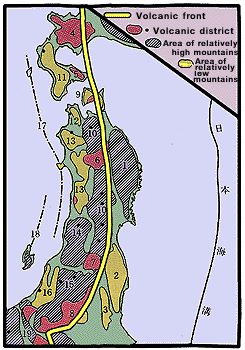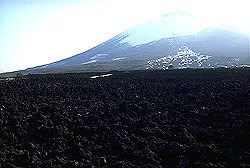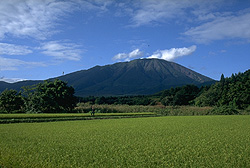The Ou mountain range is one of Japan's representative volcano zones: volcanoes found in the range include, from north to south, Mt. Hakkoda, Hachimantai, Mt. Iwate, Mt.Akitakoma, Mt. Yakeishi, Mt. Kurikoma, and Mt. Zao.
Numerous hot springs line the foot of the mountain range.
Hanamaki Hot Spring, where Kenji would take his students, is one of the products of this volcano zone.
The Japanese archipelago achieved its present shape around the middle of the Tertiary period, some 26 million years ago.
Pressure from the Pacific Plate caused great faulting and volcanic eruptions (orogenic movement), giving birth to the Ou mountain range, whose stratum generation is entirely separate in nature from that of the Kitakami plateau area to the east.
The stratum that eventually became the Ou Mountains was previously underwater.

|
1. Kitakami Mountains 2. Abukuma Mountains 3. Yamizo Mountains
4. Mt. Yotei Volcanic District
9. Mt. Osore Mountain District |
|
Volcanoes are distributed only along the western side of the volcano front. The Kitakami mountain district to the east is an old geological feature completely different in nature from the Ou mountain range. (The map is a reprint of a map in Japan's Natural Districts-Tohoku, Vol. 2, Iwanami Shoten, reprinted from Mountains in Japan (Natural Features of Japan, Vol.2), Iwanami Shoten.) |
|
Mt. Iwate, also called Nanbu Fuji, is a beautiful mountain whose skirts stretch for a long way.
From the Morioka side in particular, it closely resembles Mt. Fuji.
Mt. Iwate has several craters at the top; the old Nishi Iwatesan crater is filled to the brim with water (Lake Onawashiro).
Somma or small volcanoes including Yakushidake, the largest, surround the more recent Higashi Iwatesan crater (crater rim).
Kenji has left a lovely poem called "East Iwate Volcano," which is a record of the time he took a group of his students from the agricultural high school on a mountain climbing expedition at night through the hills around the crater.
Mt. Iwate viewed from the south, where Koiwai Farm is located, has a rough, forbidding appearance and the Onigajo (Devil's Castle) somma of Nishi Iwatesan is visible. On this side, there is a rock shaped like an eagle, so the mountain was called Ganju-san (Mt. Eagle Rock).
Eventually the Chinese characters for iwa and te were substituted for gan and ju, thus the prefecture came by its present name, Iwate.
Sugae Masumi, a writer who lived in the Edo period and documented his extensive travels in Japan, wrote:
"Someone must have made a mistake when they substituted iwa and te for the characters gan and ju." Sugae Masumi Yuranki, Heibonsha.
 Photo provided by Hiroshi Okuda. |
uLava Flowv
The white mirror of stupor
At the top of Yakushi crater
From the shadowed slope halfway down the volcano, covered with stones
Lays the frightening and sad black block lava
@@--------------------------
But here is a deep abyss of air
The dwelling of powerful devils
Not one bird is to be seen
I take dangerous steps over the blocks, one by one
And climb up a little higher
To look out further over the expanse of these once-molten rocks
A wind colder than snow blows from the peak
Clouds appear and disappear one by one
Each lava block casts its own black shadow.
The Complete Works of Miyazawa Kenji Vol.1, Chikuma Bunko
 the Big Basket Forest, and the Thief Forest". This picture was taken in a different season, so there's no snow on the mountain. |
Mt. Iwate, wearing a silver crown, spoke in a soft voice: "The thief can be none other than Thief Forest....I'll make sure he gives the millet back. So don't think badly of him. Actually, Thief Forest wanted so much to make millet cakes himself, he just could't help it."
Excerpt from Six Early Stories of Kenji Miyazawa
translated by C.W.Nicol & Gan tanigawa, published by Ushio Shuppansha.
